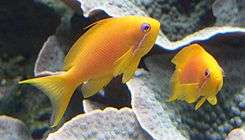Sea goldie
| Sea goldie | |
|---|---|
 | |
| Scientific classification | |
| Kingdom: | Animalia |
| Phylum: | Chordata |
| Class: | Actinopterygii |
| Order: | Perciformes |
| Family: | Serranidae |
| Subfamily: | Anthiinae |
| Genus: | Pseudanthias |
| Species: | P. squamipinnis |
| Binomial name | |
| Pseudanthias squamipinnis (Peters, 1885) | |
The sea goldie (Pseudanthias squamipinnis), also known as the lyretail coralfish, lyretail anthias,[1] and scalefin anthias, is a small species of colourful fish in the subfamily Anthiinae.
Range
The sea goldie is found in the western Indian Ocean including the Red Sea, and in the Pacific Ocean as far east as Japan and southeast Australia. It is absent from the Persian Gulf and Oman.[1]
Description
This species shows marked sexual dimorphism:[2]
- Female: Length up to 7 cm, orange/gold colour with violet streak below the eye
- Male: Length up to 15 cm, fuchsia colour with elongated third ray of the dorsal fin, a red patch on the pectoral fin, and elongated margins of the tail
The midas blenny, Ecsenius midas, goes through a phase of yellow colouration and is a social mimic of the sea goldie.[1]
The sea goldie feeds primarily on zooplankton.[2] Like other anthias, the sea goldie is a protogynous hermaphrodite; a male retains a harem of five to 10 females, but when the male dies, one of the females will undergo sex reversal and take the place of the missing male. Spawning occurs at sunset, between December and February (in the Red Sea).[3]
Habitat
The fish lives around coral outcrops in clear lagoons, patch reefs, and steep slopes to a depth of 35 m, often found in the company of Chromis diademata. They are often found in very large schools above the reef.[1]
References
- 1 2 3 4 Lieske, E. and Myers, R.F. (2004) Coral reef guide; Red Sea London, HarperCollins ISBN 0-00-715986-2
- 1 2 Froese, Rainer and Pauly, Daniel, eds. (2007). "Pseudanthias squamipinnis" in FishBase. 5 2007 version.
- ↑ Siliotti, A. (2002). Fishes of the Red Sea. Verona, Geodia ISBN 88-87177-42-2
| Wikimedia Commons has media related to Pseudanthias squamipinnis. |
| Wikispecies has information related to: Pseudanthias squamipinnis |